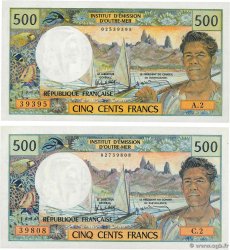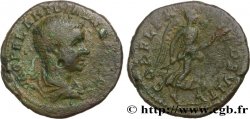- Accueil
- >
- >
fmd_160451 - Faux de 5 francs Louis XVIII, tête nue n.d. - F.309/ var.
无库存.
所有在网站上销售的产品
价格 : 140.00 €
所有在网站上销售的产品
价格 : 140.00 €
种类 Faux de 5 francs Louis XVIII, tête nue
日期: n.d.
铸币厂名称/城市 -
直径 37 mm
重量 15,67 g.
稀少度 R3
关于品相的说明
L’exemplaire a perdu sa face revers, l’intérieur est particulièrement corrodé. En revanche l’avers est relativement bien conservé
家谱
C'est l'exemplaire n° 605 du trésor de Clisson (Loire-Atlantique)
正面
正面的文字 LOUIS XVIII ROI DE FRANCE..
正面的说明书 Tête nue de Louis XVIII à gauche, les cheveux noués par un ruban ; au-dessous MICHAUT et la tête de cheval de Nicolas-Pierre Tiolier.
背面
评论
Ce faux pour servir est bien entendu totalement exceptionnel par sa technique, et à notre connaissance totalement inédit. On peut penser, à partir de ce reste, que le faussaire a aminci des écus, conservant une fine épaisseur pour l’avers et le revers, récupérant le métal, puis plaquant couche d’avers et couche de revers sur un substrat.
Mais le plus hallucinant est bien entendu la tranche.
Nous arrivons à imaginer, sans trop de difficultés, le travail d’amincir une monnaie pour récupérer la plaque de l’avers ou du revers, conservant un quart de millimètre d’épaisseur.
En revanche, il semble incroyable de constater, à l’examen du centimètre et demi de tranche qui subsiste, que quelqu’un ait pu amincir une tranche pour récupérer par ailleurs le métal de la pièce et recouvrir la circonférence de son faux.
Un spécialiste du tour à métaux pourra peut-être rédiger un article pour le BN en nous expliquant comment préserver la tranche d’un écu tout en récupérant le métal contenu.
Là, nous constatons que c’est ce qui a été fait : pour autant que nous puissions en juger, le petit morceau de tranche qui subsiste est authentique et provient d’un véritable écu.
Quel était l’aspect de ce faux pour servir lorsqu’il fut enterré et, ne l’oublions pas, trompa celui qui thésaurisa le trésor de Clisson ? Impossible à imaginer après le passage des siècles et de la pelleteuse. Mais on doit admirer le travail du faussaire qui a réalisé une bouchée farcie tellement incroyable de qualité que nous n’imaginons pas comment elle a pu être réalisée, pour la partie tranche tout au moins.
This fake serving piece is of course totally exceptional in its technique, and to our knowledge totally unprecedented. From this remainder, we can assume that the forger thinned the shields, keeping a thin thickness for the obverse and reverse, recovering the metal, then plating the obverse layer and the reverse layer on a substrate..
But the most amazing thing is of course the slice.
We can imagine, without too much difficulty, the work of thinning a coin to recover the plate of the obverse or reverse, retaining a quarter of a millimeter of thickness..
On the other hand, it seems incredible to note, upon examining the centimeter and a half of the edge that remains, that someone could have thinned a edge to recover the metal of the coin and cover the circumference of his fake..
Perhaps a metal lathe specialist could write an article for the BN explaining how to preserve the edge of a shield while recovering the metal inside..
There we see that this is what was done: as far as we can judge, the small piece of edge that remains is authentic and comes from a real shield..
What did this fake service look like when it was buried and, let's not forget, deceived the hoarder of the Clisson treasure? Impossible to imagine after the passage of centuries and the excavator. But we must admire the work of the forger who created such an incredible quality stuffed bite that we cannot imagine how it could have been made, at least for the slice part.
Mais le plus hallucinant est bien entendu la tranche.
Nous arrivons à imaginer, sans trop de difficultés, le travail d’amincir une monnaie pour récupérer la plaque de l’avers ou du revers, conservant un quart de millimètre d’épaisseur.
En revanche, il semble incroyable de constater, à l’examen du centimètre et demi de tranche qui subsiste, que quelqu’un ait pu amincir une tranche pour récupérer par ailleurs le métal de la pièce et recouvrir la circonférence de son faux.
Un spécialiste du tour à métaux pourra peut-être rédiger un article pour le BN en nous expliquant comment préserver la tranche d’un écu tout en récupérant le métal contenu.
Là, nous constatons que c’est ce qui a été fait : pour autant que nous puissions en juger, le petit morceau de tranche qui subsiste est authentique et provient d’un véritable écu.
Quel était l’aspect de ce faux pour servir lorsqu’il fut enterré et, ne l’oublions pas, trompa celui qui thésaurisa le trésor de Clisson ? Impossible à imaginer après le passage des siècles et de la pelleteuse. Mais on doit admirer le travail du faussaire qui a réalisé une bouchée farcie tellement incroyable de qualité que nous n’imaginons pas comment elle a pu être réalisée, pour la partie tranche tout au moins.
This fake serving piece is of course totally exceptional in its technique, and to our knowledge totally unprecedented. From this remainder, we can assume that the forger thinned the shields, keeping a thin thickness for the obverse and reverse, recovering the metal, then plating the obverse layer and the reverse layer on a substrate..
But the most amazing thing is of course the slice.
We can imagine, without too much difficulty, the work of thinning a coin to recover the plate of the obverse or reverse, retaining a quarter of a millimeter of thickness..
On the other hand, it seems incredible to note, upon examining the centimeter and a half of the edge that remains, that someone could have thinned a edge to recover the metal of the coin and cover the circumference of his fake..
Perhaps a metal lathe specialist could write an article for the BN explaining how to preserve the edge of a shield while recovering the metal inside..
There we see that this is what was done: as far as we can judge, the small piece of edge that remains is authentic and comes from a real shield..
What did this fake service look like when it was buried and, let's not forget, deceived the hoarder of the Clisson treasure? Impossible to imagine after the passage of centuries and the excavator. But we must admire the work of the forger who created such an incredible quality stuffed bite that we cannot imagine how it could have been made, at least for the slice part.








 对产品描述纠错
对产品描述纠错 打印
打印 分享我的选择
分享我的选择 提问
提问 Consign / sell
Consign / sell
 产品介绍
产品介绍















